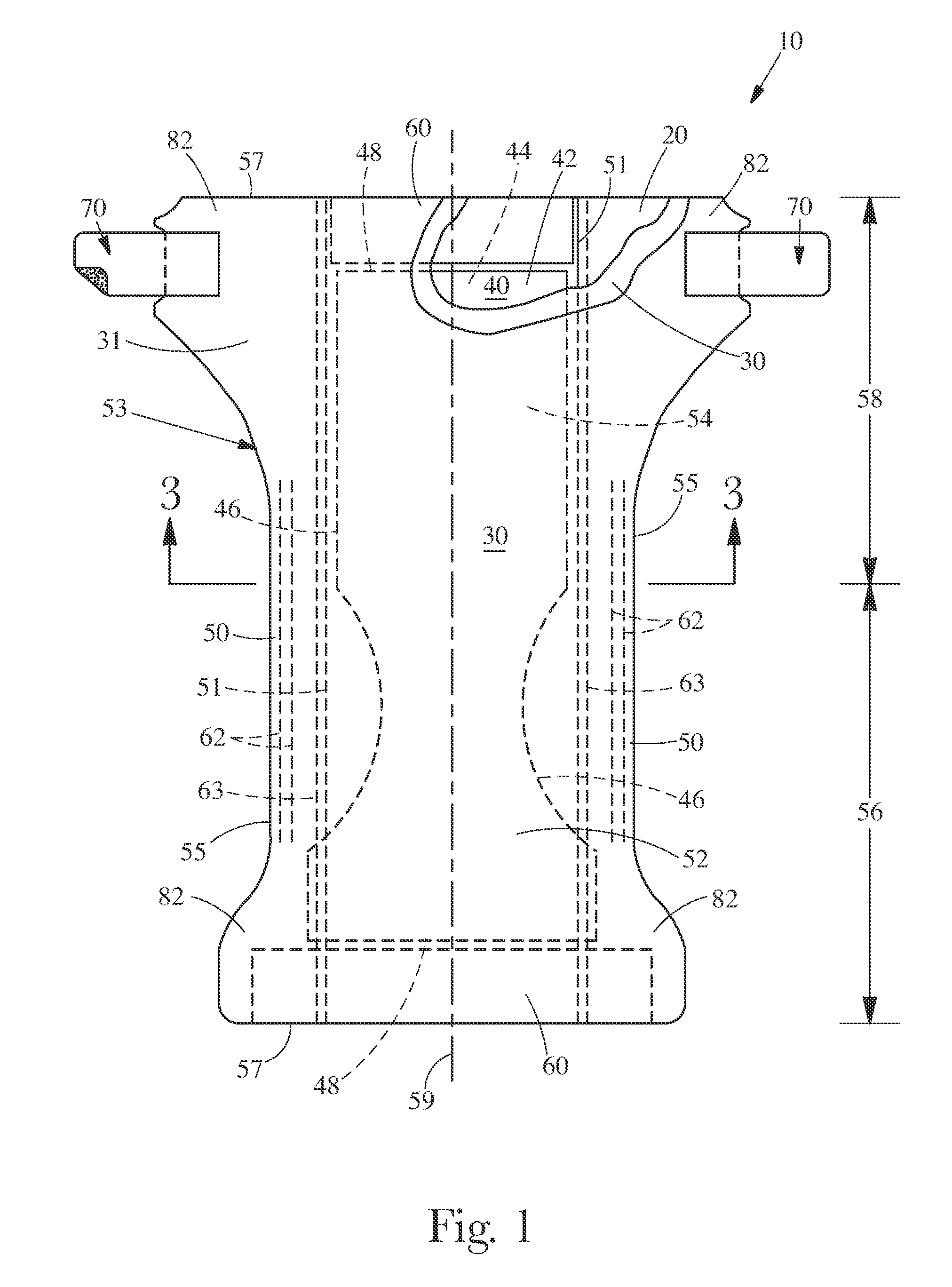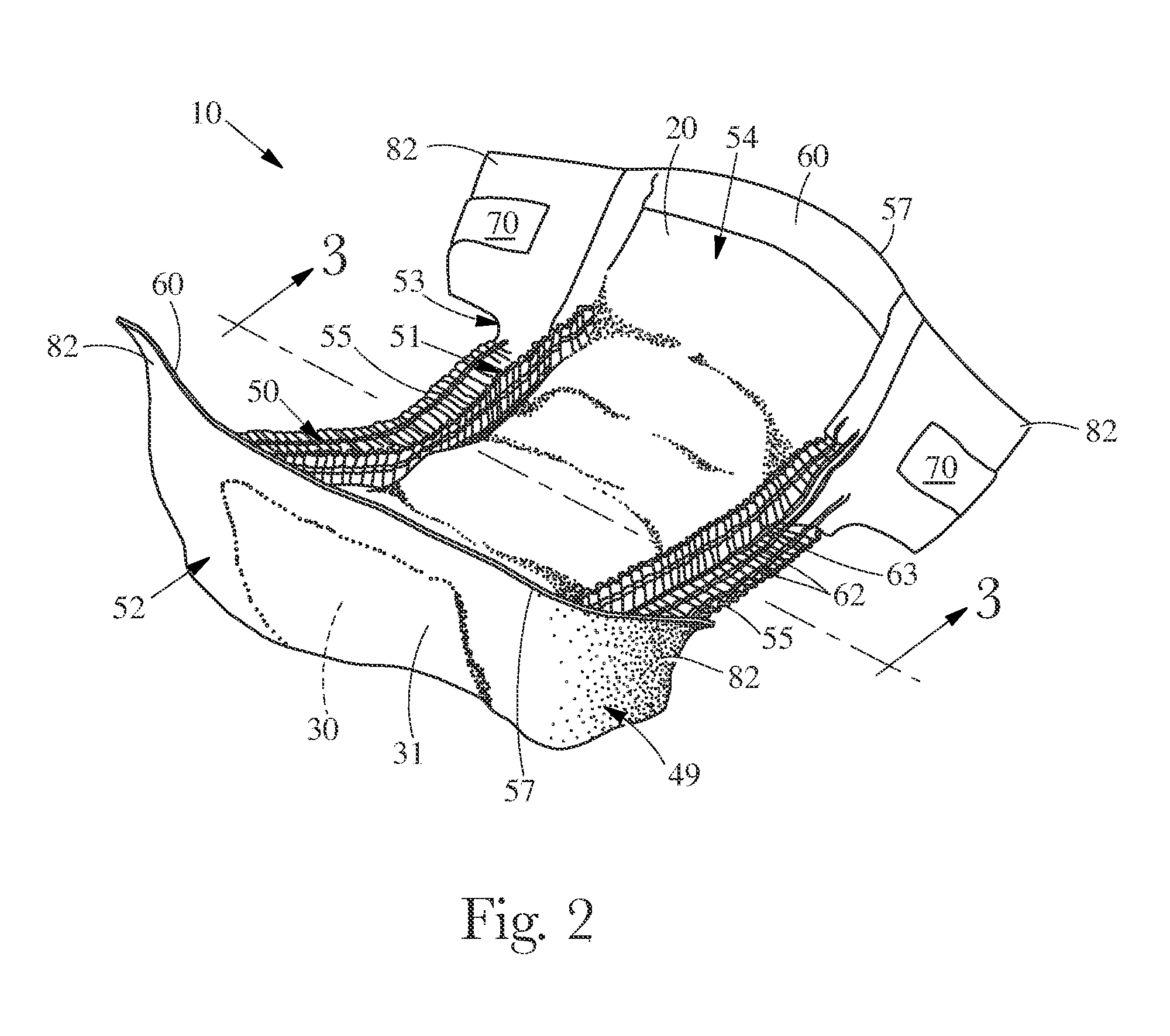Web Material(s) for Absorbent Articles
a technology of absorbent articles and web materials, applied in the field of consumer products, can solve the problems of significantly higher bond defect rate, difficulty in ensuring the quality of absorbent articles, and high manufacturing cost of absorbent articles
- Summary
- Abstract
- Description
- Claims
- Application Information
AI Technical Summary
Benefits of technology
Problems solved by technology
Method used
Image
Examples
example 1
[0252]In this example, the second nonwoven component layer 132 comprises N-fibers having fiber diameters (measured per the Fiber Diameter and Denier Test set forth herein), polydispersity, fiber diameter ranges (minimum−maximum measured), and amounts of submicron diameter fibers (less than 1 micron) illustrated in Table 1A below:
TABLE 1ANumberMassFiberAmount ofAverageAverageStandardDiameterSubmicronSampleDiameterDiameterPolydispersityDeviationRangeFibersNo.(microns)(microns)Ratio(microns)(microns)(%)N10.340.391.140.090.15-0.55>99%N20.330.451.360.090.08-0.78>99%N30.380.481.270.140.17-0.77>99%N40.680.731.080.140.40-0.98>99%N50.570.951.660.310.11-2.2392%N60.840.961.130.220.25-1.5574%N70.851.021.190.270.26-1.6079%N80.691.121.630.370.23-1.8485%N91.031.211.180.330.28-1.9843% N100.781.231.590.390.29-2.3180%
example 2a
[0256]In this example, various samples of nonwoven web materials A-i are tested. Their various properties are displayed in Table 2A. Samples G-i are embodiments of nonwoven web materials of the present disclosure, while SMS samples A-F are provided merely for comparison purposes. The low surface tension fluid strikethrough times of the various samples are illustrated graphically in FIG. 26 (with the exception of sample J to provide a graph with a better scale). As can be seen from FIG. 26, the low surface tension fluid strikethrough times of samples G-I of the present disclosure are significantly higher than SMS samples A-F, even when the SMS webs are coated with a hydrophobic coating (see SMS samples D-F). The low surface tension fluid strikethrough values are determined using two plies of each sample and a 32 mN / m low surface tension fluid.
TABLE 2ALow SurfaceTotal BasisFine FiberTension FluidAirSampleWeightBasis WeightStrikethroughPermeabilityNo.Material Type(g / m2)(g / m2)(s)(m / min)...
example 2b
[0257]In this example, various samples of nonwoven web materials A-I (same as Example 2A) are tested. Their various properties are displayed in Table 2B. Samples G-I are embodiments of nonwoven web materials of the present disclosure, while SMS samples A-F are provided merely for comparison purposes. The low surface tension fluid strikethrough times of the various samples are plotted against their number average diameter (microns) in FIG. 27. As is illustrated in FIG. 27, the low surface tension fluid strikethrough time increases based on the smaller number average diameter of the fibers in the sample. The low surface tension fluid strikethrough values are determined using two plies of each sample and a 32 mN / m low surface tension fluid.
TABLE 2BSample IDABDFGHIMaterial TypeSMSSMSSMSSMSSNSSNSSMNSHydrophobic Coating——Type 1Type 2—Type 1—Total Basis Weight (g / m2)15.716.915.215.115.515.613.3MeltBlown Fiber Basis1311——1Weight (g / m2)N-Fiber Basis Weight (g / m2)————1.51.51Spunbond Number Av...
PUM
 Login to View More
Login to View More Abstract
Description
Claims
Application Information
 Login to View More
Login to View More - R&D
- Intellectual Property
- Life Sciences
- Materials
- Tech Scout
- Unparalleled Data Quality
- Higher Quality Content
- 60% Fewer Hallucinations
Browse by: Latest US Patents, China's latest patents, Technical Efficacy Thesaurus, Application Domain, Technology Topic, Popular Technical Reports.
© 2025 PatSnap. All rights reserved.Legal|Privacy policy|Modern Slavery Act Transparency Statement|Sitemap|About US| Contact US: help@patsnap.com



